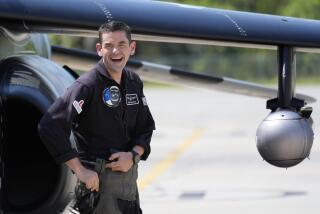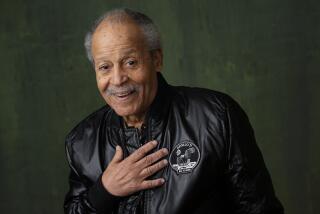Astronaut Set to Take All of Israel Into Space With Him
- Share via
MIAMI — He is a coffee fiend, father of four and combat-tested fighter jock with more than 4,000 hours in the air. Next month, if the countdown goes as planned, Ilan Ramon will climb aboard a rocket and become the first Israeli in space.
On Jan. 16, the space shuttle Columbia is scheduled to blast off from Kennedy Space Center carrying a seven-member crew, including Ramon, a 48-year-old colonel in the Israeli air force. For the native of Tel Aviv whose mother survived 1 1/2 years in the Auschwitz concentration camp, it is a sobering honor.
“Being the first Israeli astronaut -- I feel I am representing all Jews and all Israelis,” Ramon said. “The fact that I’m the son of a Holocaust survivor -- I carry on the suffering the Holocaust generation went through, and I’m kind of proof that even through all the horror they went through, we’re going forward.”
In Israel, the term “astronaut” has roughly been equivalent to “space cadet” in American slang -- that is, someone out of touch with the real world. But the 16 days the short-statured, extremely fit Ramon will spend in orbit are expected to give the Jewish state a new national hero, as well as a welcome respite from the usual dreary litany of Middle Eastern news.
“It’s like the first Israeli to win an Olympic medal,” said Mark Regev, spokesman for the Israeli Embassy in Washington, when asked to gauge the level of interest back home in Ramon’s flight. “I think all Israelis are looking at Ramon. He is the first one of us to go up there.”
The ongoing suicide bombings, shootings and other manifestations of the Israeli-Palestinian struggle, plus the mounting likelihood of a war in neighboring Iraq, “are precisely why this flight is big news,” Regev said. “It is the sort of thing Israelis will be able to feel good about.”
The mission, originally scheduled for January 2000, has been delayed several times, said Bruce Buckingham, a spokesman for Kennedy Space Center. Ramon would become the second person from the Middle East to travel on a U.S. spacecraft. A member of the Saudi royal family, Prince Sultan Salman Abdul Aziz Al-Saud, flew on the space shuttle Discovery in 1985.
Ramon, a former F-16 squadron commander and chief of weapons-system development acquisition for the Israeli air force, has been training since 1998 at the Lyndon B. Johnson Space Center in Houston, representing the Israel Space Agency.
As a payload specialist, Ramon’s main responsibility will be to use a multispectral camera in space to track dust particles from the sandstorms that blow from the Sahara over the Mediterranean and Middle East. The study, designed by scientists at Tel Aviv University, is intended to learn how the dust affects rainfall.
It is a “scientific experiment,” Ramon told reporters in Houston. “It has nothing to do with the military or reconnaissance operations.”
There have already have been a small number of Jewish astronauts, including Judith Resnik, who died in the 1986 Challenger disaster. But Ramon will be the first to adhere to Jewish dietary rules in space, eating kosher meals in sealed, self-heating pouches manufactured for the U.S. armed forces by an Illinois company.
Though he said he isn’t particularly religiously observant, Ramon has also had to ponder issues worthy of a Talmudic scholar. How, for example, to mark the Sabbath, which occurs every seven days and begins at sunset on Friday? Since it takes 90 minutes for the shuttle to orbit the earth, there arguably is a Sabbath every 10 1/2 hours in space. After consulting with two rabbis, Ramon plans to recite a kiddush on Friday evening, Houston time, if the mission permits.
The prayer is traditionally said over a goblet of wine, but since Ramon is not allowed to bring wine on the shuttle, and it isn’t practical to drink from a glass in a gravity-free environment, he will have to improvise, perhaps with a pouch of grape juice.
The five-man, two-woman crew of shuttle mission STS-107 was at Cape Canaveral for a dress rehearsal this week, touring Kennedy Space Center, boarding Columbia and conducting drills in emergency exit procedures, NASA officials said. In the fall of 2001, the astronauts took a nine-day, get-acquainted wilderness hike through the Wind River Mountains of Wyoming, and Ramon’s team spirit and unflappability left a strong impression.
“You learn a lot about people when you’re tired and hungry and carrying around a 60-pound pack for miles,” said mission specialist David M. Brown, a Navy captain who will be the crew’s flight surgeon. “He’s a guy who now only carries his own share, but always looks for an opportunity to do things for other folks.”
NASA beefed up security around shuttle launches after the Sept. 11terrorist attacks, reasoning that there was no higher-profile target for anyone intending to strike at U.S. interests or prestige. Agency officials refuse to say if the presence of an Israeli in Columbia’s crew has led to even greater measures to guard against any attempted sabotage but express assurance that security is as tight as it needs to be.
“We have taken an enormous amount of security interest, as we do with every single launch,” NASA Administrator Sean O’Keefe has said.
To see him blast off, Ramon has invited friends and relatives, as well as Ezer Weizman, a former president of Israel and one of the pioneer pilots in its air force. Ramon himself flew in the 1973 Yom Kippur War and the 1983 Israeli invasion of Lebanon, and survived a midair collision in which he ejected from his fighter jet.
Shuttle crew members are allowed to carry a small bag of personal items into space, and in his, Ramon will include a simple black-and-white drawing borrowed from the Yad Vashem Holocaust Museum in Jerusalem. It is the haunting work of a 14-year-old boy from Czechoslovakia, Petr Ginz, who died at Auschwitz in 1944. Ramon’s mother lived to be liberated by the Russians but other family members perished in the Nazis’ campaign against the Jews.
“The picture is a drawing of Petr as he imagined himself looking at Earth from the moon,” Ramon said. “I really feel I’m taking his imagination and fulfilling his wish of being there, of being his eyes.”
*
Dahlburg reported from Miami, Hart from Houston.
More to Read
Sign up for Essential California
The most important California stories and recommendations in your inbox every morning.
You may occasionally receive promotional content from the Los Angeles Times.













